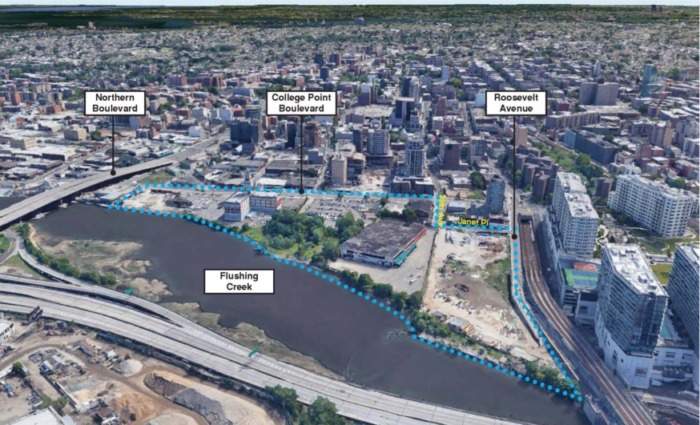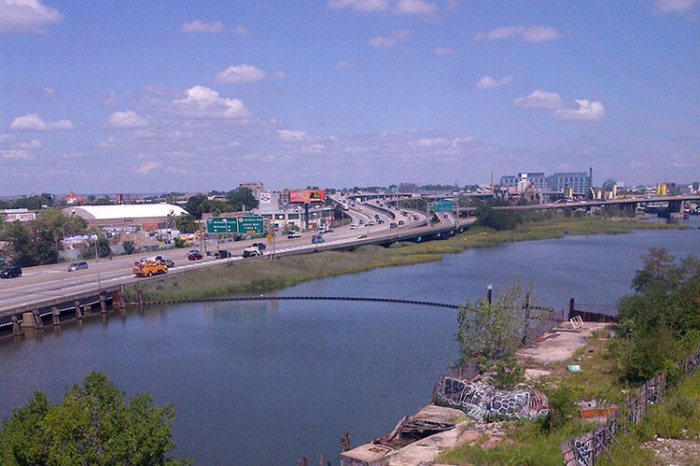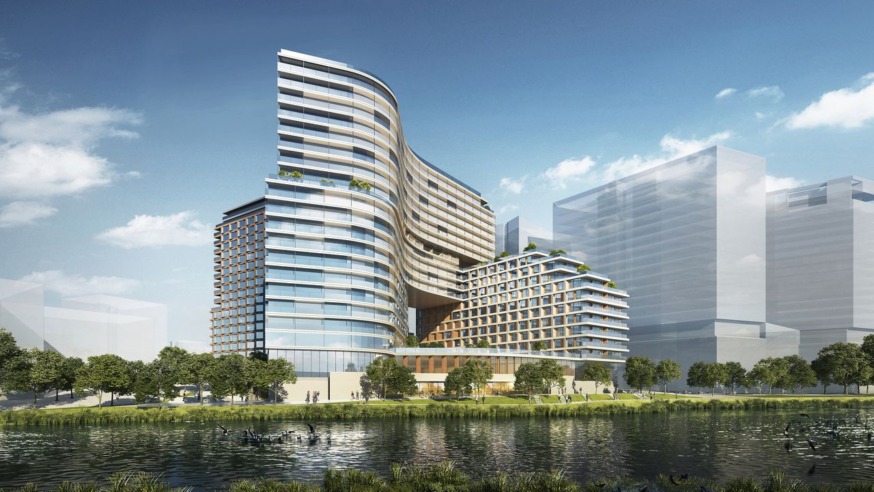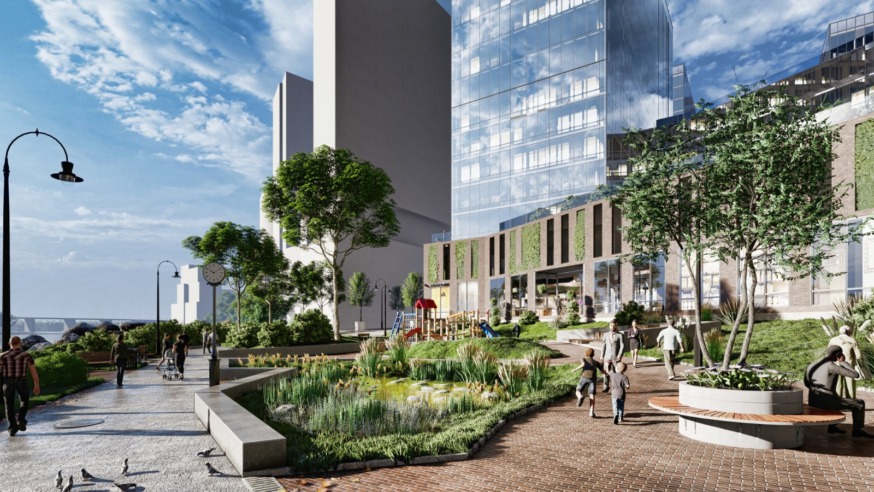
The boundaries of the proposed Special Flushing Waterfront District are represented by the blue lines (Source: Dept. City Planning)
Nov. 15, 2020 By Allie Griffin
The future of an ambitious 13-tower, mixed-use development along the Flushing Creek remains uncertain as the City Council begins to weigh in.
The fate of the “Special Flushing Waterfront District” project lies in the hands of the City Council and many members have expressed misgivings about the plan over the past week.
Multiple council members have cast doubt as to whether they will support the project in its current form — arguing the project doesn’t include enough affordable housing units among their many concerns. One member has already announced that he will vote against it.
The divisions came to the surface following an eight-hour Zoning and Franchises Subcommittee meeting last Monday, after FWRA — a consortium of three private developers — presented its plans. The group plans to construct 1,725 apartments, multiple hotels, office and retail space as well as a brand new road network on 29-acres of private waterfront property.
The plan appears to have the support of Council Member Peter Koo, who represents the Flushing district where the development would go. He said that the development would bring many benefits to the neighborhood and revitalize the underutilized, polluted waterfront in Flushing.
Koo’s voice is perhaps the most influential since the council often follows the vote of the council member whose district includes the project, in a practice known as member deference.

Flushing Creek (DCP)
However, several council members are less convinced of the Flushing project’s reported benefits. Council Members Francisco Moya, Antonio Reynoso, Justin Brannan are among those who have expressed reservations — Moya and Reynoso at the subcommittee hearing last Monday, and Brannan on Twitter.
Going a step further, Council Member Jimmy Van Bramer said outright last Tuesday that he would vote against the Flushing development — in what would be a break with council tradition should Koo vote in favor of the project.
The council members questioned the project’s credibility on affordable housing, job opportunities, its environmental impact and promised public open space.
Council Member Moya, the Zoning Subcommittee Chair, said in an interview that he cannot in good faith condone the Flushing project as is.
“Currently as it stands, it’s not something that I think I would be able to support,” he told the Queens Post.
Moya said the plans don’t include enough affordable housing. He said more needs to be offered since the city is facing a housing crisis.
FWRA’s plan makes provision for 75 to 90 affordable units. The number represents about 4 to 5 percent of the 1,725 apartments that are being proposed.
“That’s not cutting it for us,” Moya said.
The consortium of developers — made up of F&T Group, United Construction and Development Group Inc., and Young Nian Group — is only legally required to include affordable units on one of its four sites planned for the Flushing waterfront.

Special Flushing Waterfront District rendering (Courtesy of FWRA)
The one site is the only area of the 29 acres that FWRA is seeking to up-zone in order to erect a larger building. The developers must include affordable housing in their rezoning application under the city’s Mandatory Inclusionary Housing (MIH) program.
FWRA can build on the three other sites as-of-right and doesn’t need to provide affordable housing within them.
The developers’ decision to include the bare minimum of affordable housing units required by the MIH program sparked the ire of Ridgewood/Bushwick Council Member Reynoso at the hearing last Monday.
“We are in a crisis in the city of New York,” Reynoso told the developers. “Over 70,000 people are living in homeless shelters at this moment and you’re talking about nonsensical [technicalities] and saying that you don’t need to do affordable housing.
“By law, you’re absolutely right, but I’m also — as a council member — supposed to look out for the best interest for the city of New York and at this point, this project doesn’t seem to serve a purpose in getting us out of the hole that is affordable housing.”
However, a representative for FWRA said the affordable housing units are just one of the benefits the Special Flushing Waterfront District would bring the the public. He said critics should look at the plan “holistically” at the public hearing last Monday.
“We’re not suggesting that the point about affordable housing isn’t a fair point, but I don’t think you can look at it in isolation,” said Ross Moskowitz, representing FWRA.
Moskowitz said the Special Flushing Waterfront District would improve the neighborhood and help it recover from the economic crisis caused by the pandemic. The development is estimated to generate $164.6 million in annual tax revenue and create about 3,000 permanent jobs, he said.
Moskowitz also said the project would bring many benefits to Flushing— such as a network of privately-funded roads, environmental cleanup of the contaminated site and 160,000 square feet of public open space along the waterfront.

Special Flushing Waterfront District rendering (Courtesy of FWRA)
The waterfront access the development would bring earned the praise of Koo at the hearing.
“At the end of the day whatever is ultimately built needs to enhance the downtown Flushing community and open up the currently inaccessible waterfront as much as realistically possible,” Koo said. “Our community has been cut off from this waterfront far too long.”
The council member has not expressly said whether he will vote in favor of the proposal, but he has said it would be beneficial to Flushing in multiple aspects.
“I believe the proposal has many merits,” Koo said at the hearing. “There’s an MIH component, workforce development, publicly open space and opportunities to engage our community in our environmental education. At long last our community will have an accessible waterfront.”
The City Council traditionally votes in lockstep with the council member whose district includes the project.
However, Reynoso said he wants to stand with Koo should he support the Flushing project, but said that he and other council members have concerns about the plans.
One such council member is Van Bramer of Long Island City, who announced he’d vote against the Special Flushing Waterfront District application.
Van Bramer, who opposed Amazon coming to his own district, said he stands with community members in opposing the Flushing project.
“We must end this broken land use system which is above all about profit over people,” Van Bramer tweeted. “I’ll vote NO on this bad plan.”
I stand with the community, workers, Assemblymember @rontkim, and others in opposing the #FlushingRezoning. We must end this broken land use system which is above all about profit over people. I’ll vote NO on this bad plan.
— Jimmy Van Bramer (@JimmyVanBramer) November 10, 2020
Van Bramer’s announcement has been widely praised by progressive groups on twitter. He was commended for taking a stand.
However, it comes less than three months after he wrote an op-ed with Council Member Carlos Menchaca arguing that tradition of council member deference should be maintained — something Jackson Heights Council Member Daniel Dromm pointed out.
“Wait a minute! You and [Council Member Carlos Menchaca] wrote a column about member deference just three months ago,” Dromm tweeted at Van Bramer. “Now you are against it?”
Dromm’s tweet was notably liked by Southeast Queens Council Member and Queens Borough President- Elect Donovan Richards.
Richards, however, hasn’t taken a public stance on the Flushing application.
Still, Van Bramer is not alone in his opposition.
Brooklyn Council Member Brannan said he cannot support the project as it currently stands and Flushing Assembly Member Ron Kim has also publicly opposed the project — though he is not in the position to vote on it.
Several community-based groups are fighting against the proposal and have held protests to pressure Koo to reject the application.
The groups such as MinKwon Center for Community Action, the Greater Flushing Chamber of Commerce and Chhaya CDC say an influx of luxury buildings would gentrify the area and displace Flushing residents as a result.
Two influential labor unions also oppose the development. The 32BJ Service Employees International Union and the New York Hotel & Motels Trades Council have both urged the City Council to reject the Flushing development application.
The unions say that the developers haven’t committed to providing quality, well-paying jobs.
Flushing was hit hard by COVID-19. Now these developers hit the community while its down and want to build a massive development without committing to good jobs for building service workers and hospitality workers. Our communities need good jobs & affordable housing to recover. pic.twitter.com/idJqwSQXsP
— 32BJ SEIU (@32BJSEIU) November 9, 2020
Richards tweeted that he supports the two unions next to the hashtag “#FlushingRezoning” — however he has not indicated whether he is for or against the Flushing project.
However, the New York Building Congress and the Queens Chamber of Commerce have both come out in support of the development. The presidents of both organizations say the project would bring jobs and revenue to the neighborhood to help it recover from the pandemic and resulting economic crisis.
The developers reiterated at the hearing that the Special Flushing Waterfront District would create roughly 3,000 permanent jobs across its retail, office and hotel space.
Moya questioned the developers on that assertion at the hearing. He argued that none of those jobs are guaranteed since the developers will need to find retail and office tenants to occupy the space.

Special Flushing Waterfront District rendering (Courtesy of FWRA)
He also asked the developers how much profit they’d make from the project during the hearing.
Moskowitz objected to the question, which he called unfair, and said the economics vary as there are three separate land owners each building their own projects within the overall plans.
Moya pushed back on Moskowitz’s response.
“I don’t think it’s an unfair question to ask given what you’re proposing here,” he said. “We are living in a city that has an incredibly high housing crisis right now, so as these big developments are coming in and we’re seeing the low number of affordable units here, it’s only fair for me to ask what is the companies’ expected profits here.”
Moskowitz then said he would give the question more thought and get back to the council member with an answer.
With the first public hearing complete, the Council and developers are now in conversations about terms of the zoning application. Moya said he hopes to convince FWRA to increase the amount of affordable housing within the plan.
“We feel that it is imperative — especially in this climate — that the developers understand that affordable housing is a number one priority for the residents of Flushing and throughout the City of New York,” Moya told the Queens Post.
The City Council has 50 days from receiving the City Planning Commission report to review and vote on the application. The City Planning Commission voted in favor of the project 11-to-2 on Nov. 4.
The commission’s vote was in line with Community Board 7 that approved the plan in February. However, it differed from that of Acting Queens Borough President Sharon Lee, who opposed the plan saying that it didn’t include enough affordable housing and could lead to the economic displacement of existing residents.
The subcommittee vote is likely weeks away, Moya said. After the Zoning Subcommittee votes on the application, the full Land Use Committee will vote on it and then the full City Council.
If the application is approved, FWRA plans to start moving on the development right away. It hopes to complete construction by 2025.
